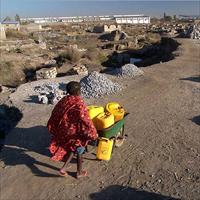SUDAN: Water shortage fears in Darfur camps

Long queues of women and children at water distribution points are a frequent sight in the Abou Shouk displaced persons camp of North Darfur. But at Mornei camp in West Darfur, the children play under gushing taps and water streams across muddy roads.
The danger of this contrast is outlined in a recent report warning that 21 camps, home to 800,000 of the 2,400,000 displaced people in Darfur, are potentially vulnerable to a severe water shortage in the event of a drought.
The report, Darfur: Water Supply in a Vulnerable Environment, by Tearfund, an international NGO, concludes that the monitoring of water use by camp residents and the understanding of underground water supply are inadequate. Its authors warn that international humanitarian actors are unprepared for the eventuality of drought.
At some locations – such as Abou Shouk, the largest displaced persons camp in North Darfur and home to more than 54,000 people – water shortages are already a reality.
“We’ve seen examples of tap stands being closed on a particular day and huge queues and struggles, as we see fights breaking out at the water points,” St John Day, an Oxfam water engineer who works in Abou Shouk, told IRIN.
“What’s happened in Darfur is that the people have been concentrated into these large camps around main villages, and the populations of the villages plus the camps have shot up. The boreholes are having to support many more people then you would normally expect to support,” he added.
Traditional coping mechanisms have broken down in the camps, where an unregulated amount of water is supplied to residents. According to the report, 94 percent of the families questioned in Abou Shouk camp said they used more water in the camps than previously in their villages.
“Darfur characteristically has poor rainy seasons every few years - they are just a normal part of life and people generally will cope with it,” said Geoff Wright, a hydro-geologist who first worked in Darfur in 1971, and also a contributor to the report. “But in these present circumstances it is going to be very hard to cope with a poor rainy season in the major camps.”
Insecurity forces many residents to remain in the camps where they rely on limited resources as a way to supplement their food and spending money.
“Free water, obviously, provides [residents] with an opportunity through brick-making and selling water to generate an income. Now that that has happened, the demand goes up quite considerably,” said Day.
Consumption unsustainable
Yet, the underlying mechanisms of aquifer recharge – the rate at which groundwater is replenished every year beneath the camps – is not sufficiently understood, according to the report. The UN Children’s Fund (UNICEF) began monitoring groundwater levels at 50 sites around Darfur. The results to date have reinforced the belief that current consumption patterns would be unsustainable in a drought year.
The rock underlying much of Darfur, known as Basement Complex, is often unable to store large amounts of water. The water that does exist underground is found in cracks and is only refilled during the three-month rainy season.
Studies of rainfall in the three regional capitals of Darfur in the report show highly variable annual levels, but slightly above-average levels in the past four years - since the beginning of the camps. “It must be expected that another poor rainy season could occur at any time, and NGOs and national authorities need to plan accordingly,” the Tearfund report states.
Brendan Bromwich, a co-author of the report, told IRIN that global warming is complicating the picture. “Climate change is about an increase in variability, in addition to being a change in the trend, and on the basis of that you have to plan for a year of drought. Sixteen of the 20 driest years in Darfur [since records began in 1917] have occurred since 1972.”
The solution, according to the report and Bromwich, is to shift humanitarian agency thinking. “There is a new approach to development here. In the beginning people had an emergency mindset, but actually people are on to the fact that livelihoods and environment are key to this crisis,” Bromwich said.
“This is a new challenge to try and do both things simultaneously - respond to a complex emergency and do that in a situation on the edge of a desert,” he continued. “We’ve got to improve the resource management of these camps so that we’re aware of whether they are vulnerable or not.”
UNICEF and Oxfam, among other humanitarian actors, have heeded the advice, and are promoting livelihoods methods that use less water, such as waterless brick-making. Loggers, which record groundwater levels, have also been installed at many locations and will monitor the amount of water underground.
Despite these efforts, a potential for water shortages remains. The arrival of 26,000 international peacekeepers early next year could exacerbate possible shortages. Julie Flint, a journalist and co-author of Darfur: A Short History of a Long War, recently said that peacekeepers would each consume up to 40 times as much as a typical Darfuri. That is the equivalent of an additional 1,040,000 displaced people.
A UN spokesperson called the allocation of water resources “a big issue of concern” for the deployment, but said the UN had been unable to make concrete plans for water management because the exact number and timing of peacekeeping troops in Sudan was still unknown.
 Back and Next - Back and Next
Back and Next - Back and Next See Also - See Also
See Also - See Also